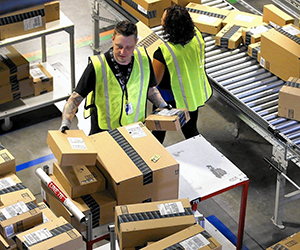The answer is: Companies that can ship the quickest and deliver product “on time” will win the business. If you miss your first promise date you better make sure you don’t miss the second. In addition, you need to notify the customer before you miss the date not after.
Once the customer loses confidence in your company’s production and delivery process, it is very hard to get that customer back. Amazon’s strategy is communicate, communicate, communicate!
Amazon tells you when your order is being prepared, they tell you when the order is shipped, and they provide you with the links to tools that allow you to follow shipment while being processed and after it is out of their hands.
If your order is delayed Amazon will tell you beforehand and provide you with new ship date that they will not miss.
The analytics needed to provide accurate production and ship dates are quite complex. They require that you know when the material will be available, when the tooling is available, when the machine is available, when labor is available. You also need to know what is the sequence that the items will run to minimize changeover and maximize production.
You might ask yourself why can’t I get schedules out of my ERP software? That’s what the expectation would be and that’s what you were sold.
ERP software will provide schedules based on the assumption that you have infinite supply and you can make everything you need at the time you need it. The ERP software does not take into account material, labor, tooling and sequencing rules.
Because of the limitation of ERP software the majority of manufactures schedule with Excel spreadsheets. These spreadsheets do not look at capacity, downtime, material, labor, tooling, etc. They can’t and don’t provide accurate ship dates to their customers. The spreadsheets act as a notepad with no underlying logic to provide accurate schedule.
What we see is that many manufacturers do not have the tools to effectively manage customer ship dates. They have very little, if not zero, visibility into the future. Their focus is purely on today. Unfortunately, action is too often taken only when the customer’s shipment is late; and that is simply not acceptable for good customer service.
For instance, a metal manufacturer who has product with two levels of Bills of Materials, might have a number of manufacturing steps at each level. If one of those steps fail, the cascade affect for that one job (and that customer order) could be significant.
The metals manufacturer has to look at several variables to effectively schedule:
- Does a given part have all the raw materials required for manufacturing and if the raw materials are not in inventory, will new Purchase Orders arrive on time?
- Is the tooling available at the time it is needed and if not, when is the soonest it can be available and what is the effect on the customer order(s)?
- Is there enough labor to make operation date for each operation step and what are the results of using some limited personnel overtime to make the promised due date?
What are the typical variables that must be incorporated into a schedule?
- Machine availability
- Labor availability
- Material availability
- Tooling availability
If any of these variables slip, then the production schedule will fail. One material delay could affect hundreds, if not thousands, of operations. This cannot be modeled in an Excel spreadsheet. This explains why many manufacturers are only managing today’s late jobs and past due jobs. They cannot look into the future and anticipate jobs that will be late. They hardly have enough time to update the spreadsheet with completed orders!
Today’s fast pace environment requires the latest in software scheduling tools to manage it. When a new customer order comes in, the manufacturer needs to have confidence that he can give accurate promise dates based on a real-life schedule. Providing not just Available-to-Promise (ATP) but also Capable-to-Promise (CTP). Not just have inventory available but promising to build the customer order as quick as possible.
If that schedule changes and it affects one or more customer orders, then the software needs to immediately alert the appropriate people of a delay in the schedule. Once a scheduler is alerted of a problem, he can make intelligent decisions on how he wants to handle the delay. He could look at potentially adding overtime, outsource, or call customer order and give new ship date.
Amazon has set a high bar for all providers of goods and services. It manufacturers don’t evolve to meet and exceed expectations, they will cease to exist and the ones that do will thrive.
The author has been working in manufacturing for the past 30 years. Feel free to contact at Gschaum@LSI-Scheduling.com/




